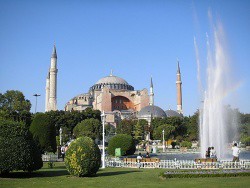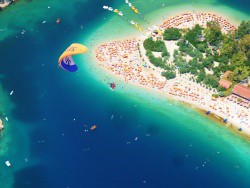Patara (Lycian: Pttara), later renamed Arsinoe (Greek: Ἀρσινόη), was a flourishing maritime and commercial city on the south-west coast of Lycia on the Mediterranean coast of Turkey near the modern small town of Gelemiş, in Antalya Province. It is the birth place of St. Nicholas, who lived most of his life in the nearby town of Myra (Demre).
Termessos or Thermessos (Θερμεσσός)[citation needed] was a Pisidian city built at an altitude of more than 1000 meters at the south-west side of the mountain Solymos (modern day Güllük Dagi) in the Taurus Mountains (modern day Antalya province, Turkey). It lies 30 kilometres to the north-west of Antalya. It was founded on a natural platform on top of Güllük Dağı, soaring to a height of 1.665 metres from among the surrounding travertine mountains of Antalya, which average only 200 metres above sea level.
Termesos is one of the best preserved of the ancient cities of Turkey.[citation needed]
Termessos constitutes an unusual synthesis of a large number of rare plants and animal species, which are under protection in the Termessos National Park. Concealed by a multitude of wild plants and bounded by dense pine forests, the site, with its peaceful and untouched appearance, has a more distinct and impressive atmosphere than other ancient cities. Because of its natural and historical riches, the city has been included in a National Park bearing its name.
READ MORE
Perga (Greek: Πέργη Perge, Turkish: Perge) was an ancient Greek city in Anatolia and the capital of Pamphylia, now in Antalya province on the southwestern Mediterranean coast of Turkey. Today it is a large site of ancient ruins 15 kilometres (9.3 mi) east of Antalya on the coastal plain. Located there is an acropolis dating back to the Bronze Age.[1] During the Hellenistic period, Perga was one of the richest and most beautiful cities in the ancient world,[citation needed] famous for its temple of Artemis. It also is notable for being the home of the renowned ancient Greek mathematician Apollonius of Perga.
READ MORE

Side (Greek: Σίδη Side, Turkish: Side) was an ancient Greek city in Anatolia, in the region of Pamphylia, in what is now Antalya province, on the southern Mediterranean coast of Turkey. It is now a resort town and one of the best-known classical sites in Turkey, near the villages of Manavgat and Selimiye, 75 km from Antalya) in the province of Antalya.[1]
It is located on the eastern part of the Pamphylian coast, which lies about 20 km east of the mouth of the Eurymedon River. Today, as in antiquity, the ancient city is situated on a small north-south peninsula about 1 km long and 400 m across.
MORE

Ephesus (Ancient Greek Ἔφεσος, Turkish Efes) was an ancient Greek city, and later a major Roman city, on the west coast of Asia Minor, near present-day Selçuk, Izmir Province, Turkey. It was one of the twelve cities of the Ionian League during the Classical Greek era. In the Roman period, it was for many years the second largest city of the Roman Empire; ranking behind Rome, the empire's capital.[1][2] Ephesus had a population of more than 250,000 in the 1st century BC, which also made it the second largest city in the world.[2]
The city was famed for the Temple of Artemis (completed around 550 BC), one of the Seven Wonders of the Ancient World. The temple was destroyed in 401 AD by a mob led by St. John Chrysostom.[3] Emperor Constantine I rebuilt much of the city and erected new public baths. The town was again partially destroyed by an earthquake in 614 AD. The city's importance as a commercial center declined as the harbor was slowly silted up by the Cayster River (Küçük Menderes).
Ephesus was one of the seven churches of Asia that are cited in the Book of Revelation.[4] The Gospel of John may have been written here.[5] It is also the site of a large gladiators' graveyard.
Today's archaeological site lies 3 kilometers southwest of the town of Selçuk, in the Selçuk district of İzmir Province, Turkey. The ruins of Ephesus are a favorite international and local tourist attraction, partly owing to their easy access from Adnan Menderes Airport and via the port of Kuşadası.
MORE
Pamukkale - Hierapolis - TURKEY
Hierapolis (Greek: Ἱεράπολις 'holy city') was the ancient Greek city on top of hot springs located in south western Turkey near Denizli.
Hierapolis is a UNESCO World Heritage Site. The hot springs there have been used as a spa since the 2nd century BCE, and people came to soothe their ailments, with many of them retiring or dying here. The large necropolis is filled with sarcophagi, including the Sarcophagus of Marcus Aurelius Ammianos.
The great baths were constructed with huge stone blocks without the use of cement, and consisted of various closed or open sections linked together. There are deep niches in the inner section of the bath, library, gymnasium and other closed or open locations. The complex, which was constructed in the 2nd century BCE, constitutes a good example of vault type architecture. The complex is now an archaeological museum.
MORE
Hagia Sophia - Istanbul - Turkey

Hagia Sophia (from the Greek: Ἁγία Σοφία, "Holy Wisdom"; Latin: Sancta Sophia or Sancta Sapientia) is a former Orthodox patriarchal basilica, later a mosque and now a museum in Istanbul, Turkey. From the date of its dedication in 360 until 1453, it served as the cathedral of Constantinople, except between 1204 and 1261, when it was the cathedral of the Latin empire. The building was a mosque from 29 May 1453 until 1934, when it was secularized. It was opened as a museum on 1 February 1935.[1]
Famous in particular for its massive dome, it is considered the epitome of Byzantine architecture and is said to have "changed the history of architecture."[2] It was the largest cathedral in the world for nearly a thousand years, until Seville Cathedral was completed in 1520. The current building was originally constructed as a church between 532 and 537 on the orders of the Byzantine Emperor Justinian and was the third Church of the Holy Wisdom to occupy the site, the previous two having both been destroyed by rioters. It was designed by Isidore of Miletus, a physicist, and Anthemius of Tralles, a mathematician.[3]
The church contained a large collection of holy relics and featured, among other things, a 49 feet (15 m) silver iconostasis. It was the seat of the Patriarch of Constantinople and the religious focal point of the Eastern Orthodox Church for nearly one thousand years. It was the church in which Cardinal Humbert in 1054 marched up to the altar and excommunicated Michael I Cerularius, which is commonly considered the start of the Great Schism.
In 1453, Constantinople was conquered by the Ottoman Turks and Sultan Mehmed II ordered the building to be converted into a mosque.[4] The bells, altar, iconostasis, and sacrificial vessels were removed and many of the mosaics were eventually plastered over. The Islamic features — such as the mihrab, the minbar, and the four minarets outside — were added over the course of its history under the Ottomans. It remained as a mosque until 1935, when it was converted into a museum by the Republic of Turkey.
For almost 500 years the principal mosque of Istanbul, Hagia Sophia served as a model for many other Ottoman mosques, such as the Sultan Ahmed Mosque (Blue Mosque of Istanbul), the Şehzade Mosque, the Süleymaniye Mosque, the Rüstem Pasha Mosque and the Kılıç Ali Paşa Mosque.
Although it is sometimes referred to as Sancta Sophia, as though it were named after a saint named Sophia (sophia being the phonetic spelling in Latin of the Greek word for wisdom), the full name in Greek is Ναός τῆς Ἁγίας τοῦ Θεοῦ Σοφίας, Church of the Holy Wisdom of God, the church being dedicated to Jesus Christ, in Eastern Orthodox theology, the Holy Wisdom of God.
MORE
Maiden's Tower - Istanbul - TURKEY

The Maiden's Tower (Turkish: Kız Kulesi), also known in the ancient Greek and medieval Byzantine periods as Leander's Tower (Tower of Leandros), sits on a small islet located in the Bosphorus strait off the coast of Üsküdar in Istanbul, Turkey.
MORE
Recent Posts
Labels
- Antalya (4)
- Bergama (1)
- Bodrum (1)
- Cappadocia (1)
- Ephesus (1)
- Hagia Sophia (1)
- Hierapolis (1)
- Istanbul (7)
- Kusadasi (1)
- Pamukkale (2)
- Perge (1)
- Side (1)
- Termessos (1)
- Topkapı Palace (1)
- izmir (4)
B Tube Other Versions
Copyright © B Tube Weblog Template.













